5 Things You Need to Know About Cupid
Cupid is the ancient Roman god of love and the counterpart to the Greek god Eros. It’s him who inspires us to fall in love, write love songs...
Valeria Kumekina 14 June 2024
Dada was certainly the most virulent European avant-garde movement. Its members attacked not only artistic creation, but society as a whole. Traumatized by the deadly World War I, and disgusted by the elitism of modern art, Dada artists used all possible means to awaken consciousness. They collectively organized and held provocative events, wrote several manifestos, distributed tracts and created hybrid works using diverse mediums. Never before has a so-called “anti-art” movement pushed the limits of artistic creation so far. Although Dada lasted for a short time, its radicality has had a huge impact in the art world. So much so that a few movements preceding it can be considered as the worthy heirs of Dada.
Let’s start with the most obvious! Neo Dada, the group, is not the same as Neo-Dada, the art term. The first is an art collective, while the second was popularized by art critic Barbara Rose to describe the works of a few artists active in the United States during the 1950s.
Like Dada, Neo Dada has been identified as an anti-art movement because their art was in opposition to traditional art institutions, abstraction, and foreign trends. This last element is somehow contradictory as, through their name, Neo Dada boldly claims their kinship with a foreign movement. But, after all, paradox is part of Dada’s DNA.
Neo Dada was also an art group strongly politically involved. Their short activity — less than a year — is closely linked with their social context. Beyond art, Neo Dada artists actively took part in Anpo Protests, which immobilized the country in 1960. The violence of the performances reflects the anger and dismay of the artists during this period.
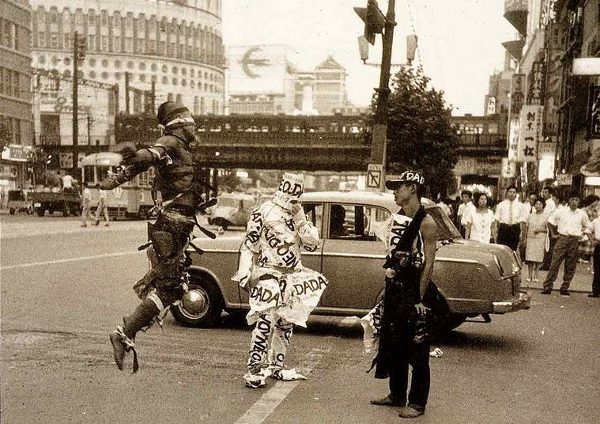
An event of Neo Dada Organizers in April 1960 in a street of the Ginza district of Tokyo. Zawiki.
Unlike Dada, who disliked the press, Neo Dada artists understood the power of the media; their scandalous appeal attracted them to it. All of their interventions were followed and commented on. Instead of impacting a small community in one city, they reached the whole country and even beyond. In a way, Neo Dada is the avant-garde of protest art.
Surrealism is directly born out of Dada. In the early 1920s, some disparities arose among members of the Dada Parisian branch. Following an ultimate argument, the group split in two. On one side, the partisans of André Breton, a.k.a the Surrealists. On the other side are Dada veterans, who quickly disband the group after the incident.
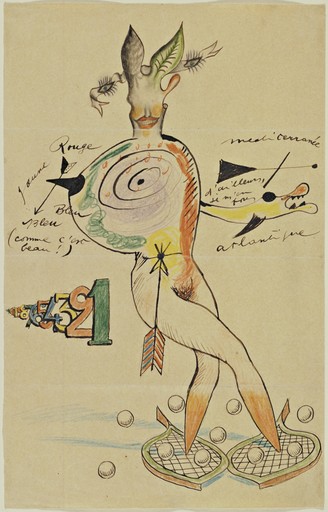
Yves Tanguy, Joan Miró, Max Morise, Man Ray, Nude, 1926–1927, exquisite corpse drawing, Museum of Modern Art, New York, NY, USA.
Just like Dada, Surrealism loathes logic and reason, considered as barriers to creative freedom. Inspired by metaphysics and Freudian psychoanalysis, they develop a culture of strangeness and marvelousness. The exquisite corpse, a collaborative blind drawing, is one of the most famous Surrealist techniques, but some artists like Dalí and Magritte developed their own methods.
In contrast to Dada’s anarchy, André Breton carefully organized the movement with a quasi despotic attitude. Despite all the problems it caused in the group, he built a creative vision that is still attractive, and even used, as of today.
Both Dada and Fluxus aim to break with an elitist art world. But where Dada looked for chaos and destruction in reaction to World War I, Fluxus artists tried to heal from the wounds caused by World War II. Although some Fluxus performances are provocative, they differ from Dada in that they invite the visitor to take an active part in the creative process, sometimes even to the detriment of the artist.
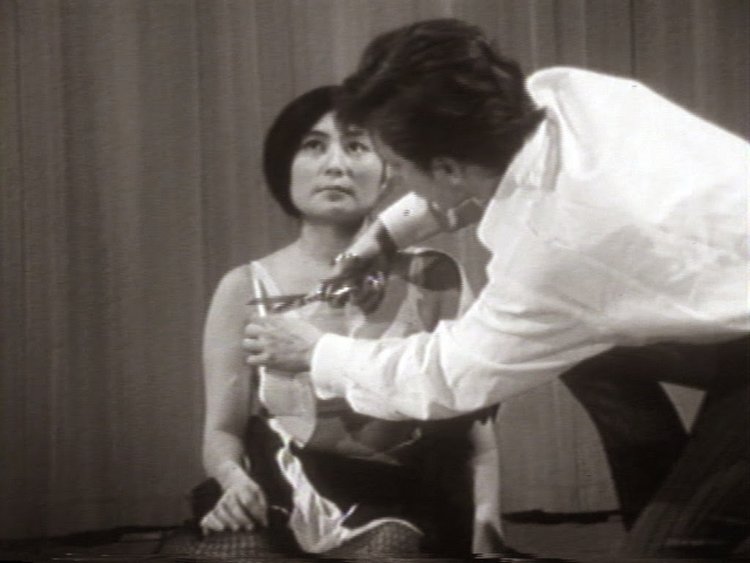
Yoko Ono, Cut Piece, 1964. MoMA
In this performance, Yoko Ono sat still, while the audience was instructed to cut parts of her clothes. Some people approached hesitantly, cutting a small square of fabric from her sleeve or the hem of her skirt. Others came boldly, snipping away the front of her blouse or the straps of her bra.
Other than these two big differences, Fluxus is the movement most similar to Dada. For one thing, both are largely renowned, but hard to define. The reason why is that they don’t have a clear aesthetic. George Macunias is a Fluxus key figure who tried to articulate a harmony out of everyone’s diverse practices. But just as its name suggests, Fluxus is unfixed. It is less an art movement than a community of artists brought together by the same ideal:
art is what makes life more interesting than art
Operating with an international network, Fluxus is as much dispersed as Dada. Although united under the same motto, each branches develop their own approach. French Fluxus uses more humor and irony than US Fluxus for example.
Gutai Bijutsu Kyôkai is an art movement principally founded and managed by Jiro Yoshihara between 1954 and 1972. More commonly just called “Gutai”, the group is yet another Japanese movement, a testament to the fruitful exchanges between the Nippon island, Europe, and the United States during the avant-garde period.
To define the guiding ideas of Gutai, Jiro Yoshihara published a manifesto in which he acknowledged the legacy of Dada. At the same time, he specified how the movement also differs from it, to avoid an overly simplistic comparison.
Unlike Dada, Gutai seeks to get rid of the ashes of the past to construct a better present. As a solution, the leader has only one watchword: “Do what has never been done before!” This tireless quest for novelty has had a lasting impact on Western art. Indeed, Gutai has developed many techniques inspiring new kinds of making art, such as happenings.
Nouveaux Réalisme —New Realism in English— group officially appear on October 27, 1960 through the Constitutive Declaration of New Realism. The art critic Pierre Restany wrote and signed it along with eight artists including Yves Klein, Martial Raysse, Arman, and Jean Tinguely.
Although the practice of these artists seem unrelated to each other, Pierre Restany highlights that they are commonly interested in using banal material from everyday life.
This mode of functioning is a common characteristic of the movements heir to Dada. Before it, artworks belonging to a same movement aesthetically looked the same. A very significant example is Cubism, where the art dealer Daniel-Henry Kahnweiler could not differentiate the paintings of Picasso and Braque. Dada disrupts this system in the sense that each artist has their own style, but achieves the same result. In their manifesto, the Nouveaux Réalisme have called it a “collective singularity.”
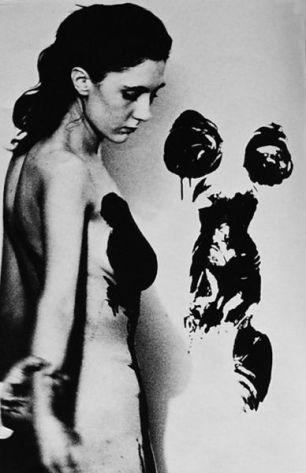
Photograph taken during a Yves Klein’s anthropometry performance, circa 1960. Bloghistoiredelartes.
Finally, the novelty with New Realism is that they don’t represent the world, they literally show it. Thus, in response to academic nudes, Yves Klein proposed a direct and non-idealized impression of the female body. However, Klein’s monochrome research was distinct from his peers, who principally used waste and industrial objects. In this, they are the worthy heirs of Marcel Duchamp.

Daniel Spoerri, Tableaux-pièges. Lecoeurauventre.
Daniel Spoerri pushed Marcel Duchamp’s readymades even further with his Tableaux-pièges. After a meal, the artist glues every element at the same exact place where they were left and hangs the result on the wall like a painting.
At first glance, it is hard to make the connection between Dada and Pop Art. It is true that both movements have antagonistic approaches. Pop art is definitively more positive than Dada in spirit.
Pop Art is often seen as the American art style. All too often, people forget that the movement originates from Great Britain, with a group of artists closer to Dada’s subversion. Before the Pop Art movement, there was The Independent Group, composed of artists such as Richard Hamilton. The very first piece ever considered Pop Art was from him.
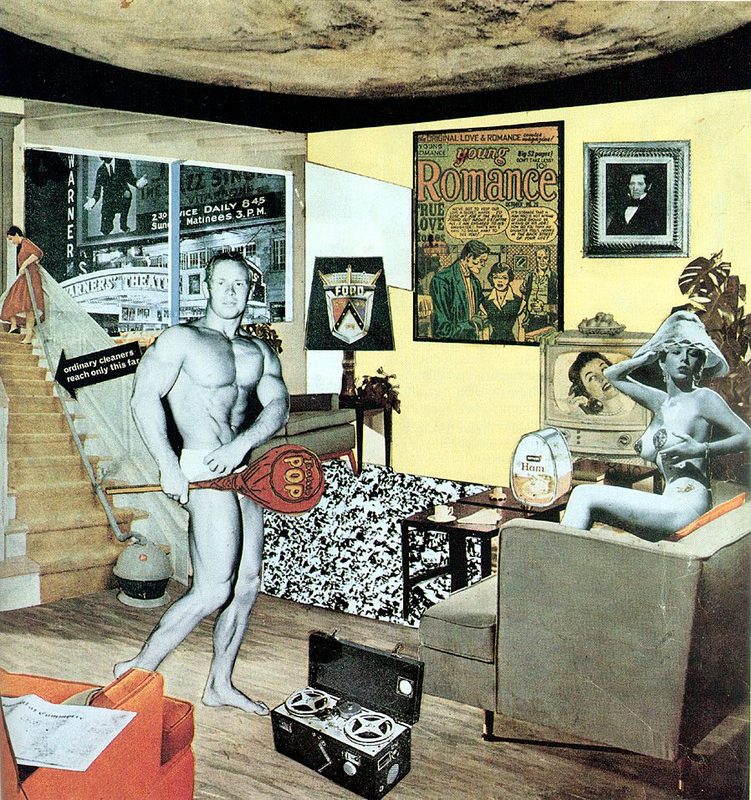
Richard Hamilton, Just what is it that makes today’s homes so different, so appealing?, 1956, Collage, Kunsthalle Tübingen, Tübingen, Germany.
Titled Just what is it that makes today’s homes so different and so appealing? the work is a collage made of magazine pictures. Between the long ironic title and the technique, this piece directly refers to Hannah Höch, the Dada collage master.
From the name to the methods, Pop Art is literally a mix between what is traditionally called Popular Culture (television, sports, comics, etc.) and High Art (visual arts, ballet, poetry, etc.). This formula is simple, yet extremely efficient. Pop Art appeals to a large audience, because there is no hidden meaning. A sort of artsy WYSIWYG.
DailyArt Magazine needs your support. Every contribution, however big or small, is very valuable for our future. Thanks to it, we will be able to sustain and grow the Magazine. Thank you for your help!